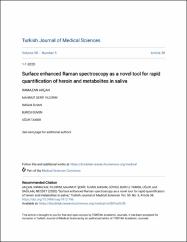Surface enhanced Raman spectroscopy as a novel tool for rapid quantification of heroin and metabolites in saliva
Özet
Background: Heroin can be detected and quantified by certain analytical methods, however, forensic professionals and criminal laboratories study for cheaper and faster detection tools. Surface-enhanced Raman spectroscopy (SERS) rises as a possible alternative tool with its widening application spectra. There are few studies regarding Raman and SERS spectra of heroin and its metabolites, which are unfortunately controversial. In this study, we compared five different surfaces in order to find out more efficient Raman-active substrate for opiate detection and rapid quantification of heroin and its metabolites in saliva. Materials and methods: Morphine standard material was used to identify proper surface for SERS analysis of opiates. Heroin and its metabolites (morphine, morphine-3-beta-glucuronide and 6-monoacetyl morphine) were calibrated between 50 ppb and 500 ppm and quantified on AuNRs with signal enhancement of silver colloids in saliva. Raman microscope with a 785-nm laser source was used. Results and Conclusion: Obtained results showed that heroin and its metabolites can be detected and quantified in saliva samples using a SERS-based system. Additionally, the present study revealed that synergetic effect of a specific gold nano-surface with ability controlling liquid motion and silver nanoparticles increase band numbers and intensities. Therefore, we suggest a fast, accurate and cost-effective method to detect and quantify heroin in biological fluids.
















